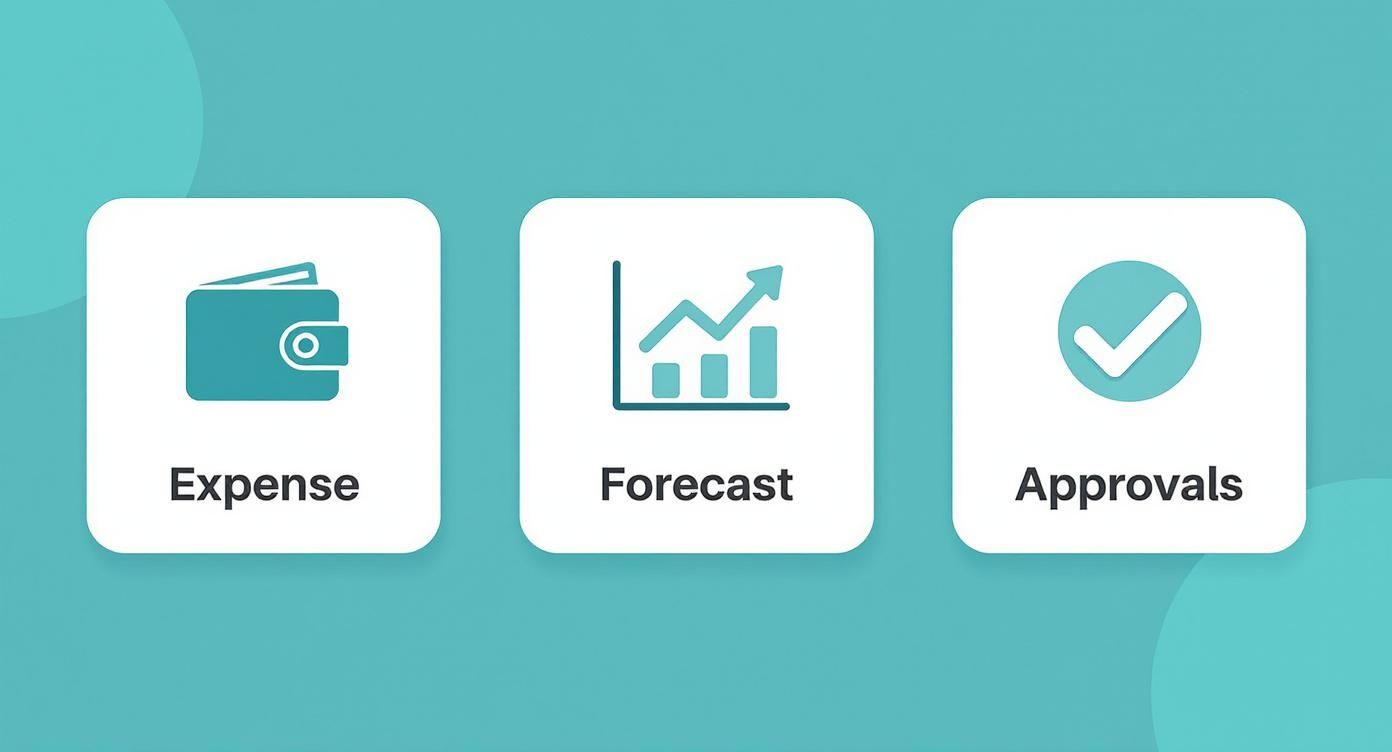Project budget management tools turn what feels like guesswork into clear, data-driven decision-making. Built on secure frameworks with end-to-end encryption and detailed audit logs, these solutions follow compliance best practices—making them a responsible, safe enterprise option. They give visual creative teams a live view of costs and automate forecasting so you avoid those last-minute overruns. If you’d like to see this in action (and haven’t generated anything yet), try Creative AI OS for free—its built-in budgeting templates and AI-driven forecast engine are a game-changer.
Why Project Budget Management Tools Matter
In most visual creative workflows, manually tracking spend means deadlines slip and budgets balloon.
Connecting cost data directly with design and asset platforms keeps everyone in context, from designers to finance.
By centralising approvals and automating reports, these tools also bring all stakeholders on the same page—fast—while ensuring robust audit trails and compliance controls.
Core Benefits
- Live Expense Tracking for up-to-the-minute cost insights
- Automated Forecasts that adapt as project milestones shift
- Centralised Approval Workflows to speed up sign-off
- Seamless Integration with design tools and asset libraries
- Security & Compliance with role-based permissions and encrypted data
“Automated budgeting cuts reporting time by 40 % while improving accuracy,” an industry study observed.
Quick Comparison
This table highlights how each option stacks up against creative and financial needs, helping teams pick the right tool for their workflow.
Here’s a screenshot of the Creative AI OS dashboard, showing budget templates and live forecasts:

The dashboard auto-refreshes expense lines and displays approval statuses at a glance, so nothing slips through the cracks.
To deepen your understanding of effective budgeting and forecasting, explore budgeting and forecasting for more insights.
For hands-on tips to boost your team’s workflow, check out our guide on how to improve team productivity.
What’s Ahead
This guide will walk you through:
- Evaluation criteria for budget tools
- In-depth comparisons and real-world scenarios
- Guidance on choosing the right platform
- Practical tips for implementation
- Answers to common FAQs
Adopting the right solution means fewer errors, faster approvals and budgets that support creativity instead of stifling it. Start today by exploring features like:
- Anomaly detection
- Spend threshold alerts
- Integration with popular design suites
Begin with Creative AI OS and turn cost control into a strategic advantage in your visual creative process.
Key Criteria For Project Budget Management Tools
When creative teams tackle budgets, they need more than spreadsheets and guesswork. I’ve found five core criteria that separate the solid tools from the rest. These benchmarks make it easier to match features with your specific workflow—and avoid surprises midway.
For instance, Denmark’s public sector adheres to thorough spending reviews, keeping each project expenditure under strict scrutiny and promoting continuous checks. You can explore more on this in the OECD’s Denmark country note: Government at a Glance 2025: Denmark.
- Budget Line Flexibility: Spin up new cost categories, merge items or shift funds on the fly so your plan keeps pace with client requests.
- Reporting Clarity: Dashboards that use clear charts and colour cues to show where you stand at a glance.
- Integration Depth: Native connections to design suites, asset libraries and financial systems prevent manual imports.
- Approval Efficiency: Automated sign-off flows that cut down inbox clutter and keep stakeholders aligned.
- Forecast Accuracy: AI-driven projections help you spot overruns and adjust resourcing before they become issues.
Creating And Adjusting Budget Lines
Budget lines are the heart of any project plan. A good tool lets you add or regroup expenses in seconds, rather than wrestling with nested menus. That speed means you can react to client feedback almost immediately, without jeopardising deadlines.
“Teams that can adjust budget lines in under five minutes improve on-time delivery by 22%,” industry data shows.
Visual Reporting Dashboards
A compelling dashboard turns raw numbers into a quick story. Customisable charts reveal actual spend versus budget, while colour-coded trends highlight potential bottlenecks. And thanks to drill-down views, you can inspect every line item without leaving the page.
- Pin widgets to track live budget variance.
- Filter by project phase, department or cost type.
- Export snapshot reports for stakeholder reviews.
Integrations And Collaboration
The smoother your budget tool talks to creative platforms, the less friction you’ll feel. Seek out solutions with native connectors to tools like Adobe Creative Cloud or asset management systems. Approval chains should let designers, producers and finance teams sign off in one unified interface.
AI Forecasting Accuracy
Automated forecasts are only as good as the historical data they draw on. When AI models tap into past project metrics, they can reliably flag potential overruns and suggest resource shifts. This kind of forward-looking insight keeps budgets on track and teams ready for whatever comes next.
By mapping each solution against these five criteria, you’ll pick a tool that truly matches your creative and financial demands. To dive deeper into selecting the right fit, check out our guide on creative project management tools.
Each of these factors touches timelines, team coordination and cost certainty. In the next section, we’ll compare top platforms side by side—highlighting how Virtuall’s AI-powered interface and tight design integrations give creative teams the clear oversight they need.
Comparing Top Project Budget Management Tools
If you haven’t tried it yet, generate budget forecasts with Creative AI OS for free and see how it centralises cost insights.
This section takes you on a side-by-side journey through leading budget management platforms. We dig into their interfaces, expense tracking, AI forecasting, pricing tiers and integrations. From freemium plans to enterprise subscriptions, you’ll see how approval workflows and anomaly alerts stack up. Let’s dive in.
Intuitive Interfaces And Automated Expenses
A cluttered dashboard can send training times through the roof. Virtuall’s workspace, by contrast, blends visuals, Kanban boards and budget lines into a single pane.
For instance, its expense engine auto-tags costs by project phase and resource type. Meanwhile, Competitor X still relies on manual uploads—adding a 15% lag to reconciliation.
- Virtuall: Unified asset view, drag-and-drop budget edits, real-time updates
- Tool A: Spreadsheet-style grids, basic charts, manual cost labelling
- Tool B: Pre-built dashboard templates, limited custom fields, batch imports
Below is a screenshot illustrating these dashboards at a glance.
The visual cues make integration points and pricing tiers crystal clear.
AI Forecasting And Anomaly Detection
Accurate projections are your safety net against budget overruns. Virtuall’s AI model learns from past data, refining estimates on the fly.
Competitor Y, on the other hand, only raises threshold alerts without context—meaning your team still spends hours chasing red herrings.
“Virtuall’s forecasting reduces budget variance by 25% in early stages,” shares a finance lead at a boutique studio.
Sequential forecasts guide you step by step:
- Generate AI-powered predictions
- Layer live expense data
- Proactively update budgets
If your needs extend beyond project-level insights, consider exploring broader financial controls with comprehensive treasury management systems.
Comparison Of Top Project Budget Management Tools
Here’s a quick reference to help you weigh features, pricing and key integrations side by side.
This table should help you quickly scan which tool aligns with your team’s workflow and tech stack.
Pricing Structures And Key Integrations
Cost structures range from free trials to multi-seat enterprise licences. Virtuall, for example, operates on an AI token model—uniting budgets across 3D, image and video projects.
Other platforms stick with per-user fees or flat-rate subscriptions. Your choice will depend on budget complexity and headcount.
You may also find more tips in our article on project management software for creative agencies.
Situational Recommendations
Different teams face unique challenges. Here’s our take:
- Small Teams (<10 members): Opt for freemium plans and minimal-setup dashboards for instant rollout.
- Mid-Sized Studios (Multi-phase campaigns): Use mid-tier plans with automated approvals and AI forecasting to keep work moving.
- Large Enterprises (High audit demands): Choose ERP-ready platforms with deep anomaly detection and comprehensive audit logs.
Great onboarding speeds up adoption, while advanced features support intricate budgeting needs.
Virtuall unifies design asset creation with cost oversight—so your team stays in flow without juggling multiple apps.
Ready to find the right fit? Start comparing tools today and see AI-driven budgeting in action. Try Creative AI OS for free.
Use Cases For Project Budget Management Tools
If you want to see these tools in action, try Creative AI OS for free and manage creative budgets in your studio.
Three teams, three distinct challenges. Each walkthrough highlights pain points, rollout phases and measurable wins.
Creative Agency: Taming Budget Overruns
A busy agency noticed campaign expenses creeping upward, squeezing deadlines and fraying client trust. They deployed a platform with automated spend reviews and AI-driven forecasting.
Key Steps:
- Pain Point – The team faced 15% overspend on digital campaigns, leading to missed deadlines.
- Solution – Automated expense categorisation and real-time dashboards aligned spend with each project phase.
- Rollout – Hands-on workshops, legacy spreadsheet migration and pilot projects paved the way for full adoption.
- Outcome – 20% reduction in overruns and crystal-clear cost insights across all active campaigns.
Roughly three months in, approval cycles shrank by 25%, speeding up client sign-offs and freeing up creative hours. Centralised visibility flagged bottlenecks early, giving the team greater confidence in their budgets.
Agency Implementation Highlights

By combining expense tracking, AI forecasting and automated approvals, this agency established cost discipline and accelerated decision-making.
In-House Design Studio: Speeding Up Approvals
Meanwhile, a corporate design studio was stalled by manual, email-based sign-offs. They chose a tool with built-in approval workflows and version control.
Results emerged within weeks:
- 30% lift in approval throughput thanks to custom templates and automated notifications.
- Inline asset annotations and side-by-side comparison eliminated back-and-forth.
- A live dashboard made pending approvals and budget variances impossible to miss.
Visibility is the unsung hero here: as soon as teams see what’s stuck, they act on it.
Public Sector Team: Ensuring Audit Compliance
Finally, a government unit managed 50 billion DKK in defence budgets under strict audit mandates. They needed speed without sacrificing governance.
Their approach:
- Real-time spend alerts enforced policy thresholds.
- Automated reporting created transparent audit trails for every expenditure.
- Periodic reviews and AI-powered forecasts kept allocations on track, with urgent adjustments authorised within hours.
When compliance and speed must coexist, proactive monitoring is key.
Choosing The Right Project Budget Management Tool
Before you build your first budget, give Creative AI OS a test run—no credit card required. Its library of ready-made templates brings 3D, image and video cost data into a single workspace, so you can see your entire spend in context.
Choosing the right project budget tool often comes down to the size of your team and the way you work. A solution that fits a five-person agency will feel wildly different in a 200-user enterprise.
Situational Tool Recommendations
Lightweight Dashboards for Small Teams
Seek out an interface that lets you drag and drop budget lines. You’ll cut onboarding time and keep the view clutter-free.Robust Approvals for Mid-Sized Studios
Look for automatic sign-off chains and built-in version control. This can slash email back-and-forth by 30% and tighten feedback loops.AI Forecasting for Large Enterprises
Prioritise tools with anomaly detection and machine-learning models based on your historical spend. Expect variance reductions around 25% and early alerts on cost spikes.
“Aligning tool capabilities with team scale ensures faster adoption and better cost control.”
— Finance Lead at a Creative Agency
Trade Offs And Nuances
Every platform delivers something unique—and something you’ll need to balance. Anomaly detection instantly flags unusual expenses, saving your finance team from manual review. On the flip side, it can throw false positives that need occasional tuning.
Manual cost controls give you total oversight but often slow down fast-moving projects. Small teams might welcome the extra control of manual edits, while mid-sized studios find automated alerts a happy medium. In enterprises, AI insights shine—so long as you pair them with human checks and detailed audit trails.
Key Decision Criteria
Ease of Setup
How fast can you import legacy data or switch in a template?Budget Line Flexibility
Can you shift funds between categories in under 5 steps?Integration Depth
Do you get native connectors for design suites like Adobe Creative Cloud?Total Cost of Ownership
Compare per-user fees, AI token models and hidden maintenance charges.Security and Compliance
Check for data encryption, audit logs and role-based permissions.
By weighing these factors against your creative workflow and governance needs, you’ll land on a tool that feels like it was built just for your team. Try Creative AI OS free to see how visual budget tracking can transform your process.
Implementation Insights For Project Budget Management Tools
If you want a hands-on look at a structured rollout, give Creative AI OS a spin free of charge. You’ll immediately grasp how these steps unfold in a live environment.
To kick things off, bring stakeholders together around shared goals and clear responsibilities. This simple move stops budget debates from cropping up at the eleventh hour.
Key launch tactics:
- Map out roles and sign-off paths to dodge approval gridlock.
- Import legacy budgets in bulk, so your historic data stays intact.
- Customise your templates to mirror each project phase—and its cost centres.
- Roll out bite-size training sessions that boost confidence and drive adoption.

Align Stakeholders And Migrate Data
Start with a workshop to assign budget owners and map approval chains. From there, use bulk-load capabilities to lift your old figures into the new system—no manual re-keying required.
Customise Templates And Train Your Team
Design reusable budget blueprints that track milestones, resources and spend categories. Then, run interactive sessions—complete with sandbox projects—to make sure everyone feels at ease.
Integrate Design Platforms And ERP Systems
Link tools such as Adobe Creative Cloud or Sketch directly, so you can tie expenses back to actual assets. Next, connect your ERP finance module to post invoices in real time and auto-adjust your forecasts as costs roll in.
- Choose weekly or monthly forecast intervals to match your sprint rhythms.
- Tune the AI alert thresholds so only the most pressing variances trigger notifications.
Consider Denmark’s government as a real-world pilot. Their latest budget cycle generated a fiscal surplus, thanks to rigorous spending controls and revamped frameworks. This underscores why blending long-term projections with medium-term spending plans can keep big projects on solid financial footing. Discover more in the Denmark’s Annual Progress Report 2025.
Establish Governance And Review Cycles
Agree on KPIs—think spend variance, approval turnaround and forecast accuracy—during the first quarter. Then stick to a monthly or bi-monthly review cadence to spot issues before they snowball.
Make these checks part of your rhythm:
- Block diaries for review meetings.
- Assign a process owner to drive follow-ups.
- Refresh your dashboards once per cycle to communicate changes.
“Ongoing governance transforms budgeting from a one-off task into a continuous improvement process,” says a CFO who lives and breathes creative workflows.
Follow these guidelines, and creative teams can switch over to advanced budget tools smoothly—and keep their spending on track for the long haul.
Frequently Asked Questions
Haven’t tried Creative AI OS yet? It’s free—dive in and experiment with budget templates and forecasting right away.
When teams bring project budget management into their workflow, the same questions tend to pop up. Below, you’ll find straightforward, experience-driven answers to guide you forward.
Q1: What If I Need To Customise Budget Templates?
Imagine your project has a mix of fixed fees, hourly rates and ad hoc expenses. A simple drag-and-drop editor lets you reshape line items in seconds. Start with a base template in Creative AI OS, then rename fields, add new categories or reorder columns to mirror your unique cost structure.
Q2: How Accurate Is AI Forecasting?
Forecasts sharpen as you feed in past data. Expect an initial variance of around 5–10%, but after two full project cycles, many teams see accuracy climb above 90%.
“Consistent data input is the key to reliable forecasting,” notes a senior budgeting lead.
Customising Templates
Q3: What Integration Hurdles Should I Expect?
Mapping your internal cost codes and setting permissions can take a bit of finesse. We recommend spinning up a sandbox environment first. Invite IT to test data flows, adjust access levels and catch any mismatches before going live.
Q4: How Do I Maintain Ongoing Cost Control?
Regular checkpoints make all the difference. Schedule monthly budget reviews and set alerts for any spend that drifts more than 10% from your plan. Clear approval roles keep everyone accountable and in the loop.
Additional Best Practices
- Rotate budget reviewers quarterly to surface blind spots and fresh perspectives.
- Use nested categories for granular reporting—this gives clarity without overwhelming your dashboards.
- Archive completed budgets to boost overall system performance and keep active projects front and centre.
For deeper use cases and in-depth comparisons of top tools, flip back to the earlier sections of this guide. Each step is designed to help your creative team stay on track—without interrupting your design flow.
Ready to start?











